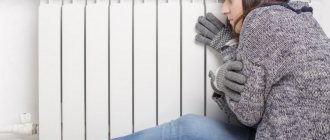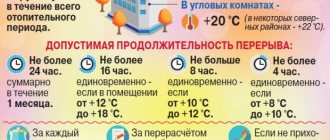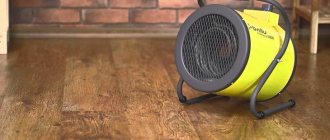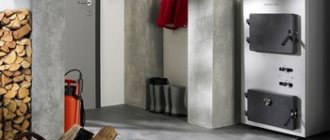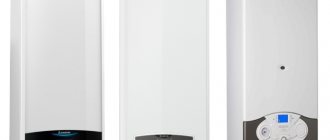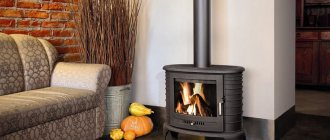Normative base
Ensuring optimal thermal conditions in a room is based on several regulatory documents. Here are the most important ones:
- Federal Law dated 07.12.11 No. 416-FZ in Art. 7 (Chapter No. 3) fixes the general provisions of the rules on the basis of which the thermal regime in buildings is regulated.
- Government Resolution No. 354, adopted on 05/06/11. The “Rules for the Provision of Utility Services” approved by him fix the standards for the supply of thermal energy to owners and users of residential real estate and premises in apartment buildings.
Attention
Based on these documents, management companies are engaged in the acquisition of thermal energy and collecting fees from owners to pay for supplies. The provisions are disclosed in more detail in the agreement between the heat supplier and the management company, as well as in the internal instructions of the management company. However, they cannot contradict basic regulatory documents approved at the federal level.
Useful video
Details about degrees:
The annual rise in price of resources forces the end consumer to think not only about their savings, but also about the quality of the utility services provided. One of the most significant expense items in paying for an apartment is heating, so consumers monitor its parameters especially carefully. To do this, it is worth finding out what the normal temperature of the batteries in the apartment is in 2019.
Types of heating in residential buildings
There are many technical schemes designed to ensure optimal temperature conditions in the room. They differ in performance, efficiency, cost and design complexity, and ease of use.
In the most general form, all residential heating systems can be divided into three groups:
- Individual systems provide thermal conditions in one household. Most often, this option is implemented in private homes. For multi-apartment buildings in Russia, such a scheme is exotic, although it is used in some new buildings. Its main advantages are the ability to independently regulate the temperature in the room, finely adjusting to every change in the weather. The disadvantage is the high cost.
- Centralized systems receive heat with a coolant from the main line, and then distribute it among apartments. Most apartment buildings implement just such a scheme. Its advantages are efficiency and relatively low charges for thermal energy. However, it does not allow you to adjust the heat supply to a specific situation, which is why it can be cold in the apartment before the start of the heating season, and too hot when a sudden thaw occurs.
- Autonomous heat supply. In this case, the heat is distributed throughout all rooms of the apartment building, but the energy source is not the supply line from the thermal power plant, but an autonomous boiler house. In most cases, such systems are implemented for industrial buildings or social facilities (schools, hospitals, etc.). In terms of its advantages and disadvantages, this option occupies an intermediate position between the first two options.
But no matter what method is implemented, it must ensure that the temperature regime of the building complies with sanitary standards and regulatory documents in the field of heat supply.
Coolant temperature measurement
The heating system runs on hot water. It is this that is considered the coolant. To measure the temperature yourself, you need to fill a glass with hot water and place a thermometer in it. Temperatures should be between 50-70 degrees.
There are other methods for measuring heating. Temperature determination is performed near pipes or radiators.
An infrared thermometer-pyrometer is used for this. An alcohol thermometer is suitable, which should be placed on the pipe and covered with insulation.
There is more complex equipment - an electric thermometer. It is applied to the pipe, secured and measured. Each device has a deviation scale.
Building regulations
The design of the heating system of a residential building is carried out in accordance with regulatory documentation - GOSTs and SNiPs. The most important of them include:
- SNiP 2301-99. This document describes the temperature regime in premises for various purposes, which must be provided by the heating system.
- SNiP 4101-2003. The document regulates ventilation and heat supply to rooms depending on their purpose.`
- SNiP 2302-2003. Based on this document, thermal insulation of premises is created. Without this data, it is impossible to accurately calculate home heating standards.
- SNiP 4102-2003. This document contains the latest changes in the regulations for the organization of centralized heating.
For your information
, there are other standards that are applied taking into account the specific features of the heating supply of a building, for example, when installing a gas heating system. If the heating system of a residential building does not comply with regulatory documentation or cannot provide the required temperature conditions, the building cannot be used for its intended purpose; all disruptions in the operation of communications must be eliminated.
Heating standards in a residential building
A consumer of thermal energy, that is, a homeowner or a person permanently residing in this house, does not need to know all the intricacies of regulatory documentation and the rules for organizing a heating system. But everyone needs to have an idea of what thermal conditions the heating system of a residential building should provide. Here are the basic requirements and rules that apply to residential and utility premises:
- In living rooms, the temperature should be between +20-+22 degrees. A short-term deviation up or down is allowed, but fluctuations of more than 2 degrees are not allowed.
- The temperature in the kitchen and toilet should be 1 degree lower than in living rooms. It is allowed to increase it to +26 degrees, this is due to the use of a gas stove or other heating appliances in the kitchen. But the maximum permissible temperature drop is the same as in residential premises.
- In the bathroom, the temperature level should be higher and be within +24-+26 degrees.
- In corridors and staircases, where a person goes out in warm clothes, the temperature should be within +16-+18 degrees.
Additional information
As practice shows, it is the temperature regime of staircases and flights that is most poorly observed - this is due to high heat losses. However, such a violation will certainly lead to cold weather in the apartment, so residents have the right to file a complaint with the Criminal Code.
What to do with cold batteries
You need to find an agreement on the provision of heat supply services, which contains the address and telephone number of the organization. You can also find the emergency number there. This is where you should go. According to Resolution No. 354, such information is indicated on the notice board, which should be located at each entrance.
Then you need to call the emergency dispatcher. When calling, indicate your name, address and describe the problems that have arisen. The call is recorded in the log as confirmation of the call. Within two hours, a specialist must be sent to the specified address to find out the cause of the situation.
If the lack of heat is caused by a utility failure, the dispatcher will report this immediately. Major breakthroughs and accidents are eliminated quickly, so there is no need to worry.
The situation is worse if one riser does not work or the heating does not meet the standards. In such a situation, utility workers are in no hurry to establish a heat supply, especially if we are talking about an old building or a problematic new building. In such a situation, you need to complain and demand a recalculation of the fee for the service.
How to file a complaint
In such cases, a written appeal is written to the management company, housing cooperative, homeowners association, which service intra-house networks. If there is low pressure in the pipes and low water temperature, in accordance with No. 190-FZ dated July 27, 2010 “On Heat Supply,” you should contact the heating network or heat supply organization. Be sure to ensure that the request is included in the incoming documentation log. Now you can submit an application through your personal account - it’s simple, convenient and saves time.
The complaint is written in any form. It indicates the name of the organization with which the heat supply agreement was concluded, the applicant’s details and address. The situation is briefly described. Date and signature are added. If there are documents - acts, photographs, receipts, they are attached to the application.
The organization to which the complaint is sent is obliged to respond promptly. A specialist will be sent to the address who will confirm the poor provision of the service and draw up a corresponding document. If the management company, housing office, housing cooperative, Heating Network, REU have ignored the appeal, you should contact the Housing Inspectorate, the prosecutor's office, Rospotrebnadzor and the city administration. In many localities there are “hotlines” that accept calls on such issues.
Where to go with a specific heating problem
- Utility accidents are associated with wear and tear of communications. A common winter problem. It is necessary to call the heat supply or heating network organization and call the emergency service.
- Low temperature - wanting to save fuel, thermal engines heat the media slightly, below the temperature norm. In this case, a complaint is filed with the heat supply organization.
- Poor performance of intra-house communications - wear, blockages, problems with return lines, miscalculations in design. Contact the management company, housing cooperative or other organization servicing apartment buildings. You can additionally complain to the city administration and Rospotrebnadzor.
Blockage in the battery - how to identify and fix it
A common indoor cause of cold radiators is clogged radiators. Blockages occur due to deposits and dirt. You can determine the problem by opening the Mayevsky tap. Dirty liquid will leak.
Repairs are carried out as follows:
- The inlet valve is closed.
- The device is disconnected and disassembled.
- Clogged elements are washed under pressure in the bathroom. Then a solution of vinegar or calcined salt is poured into them and washed again.
- The washed elements are installed in place.
It is advisable to remove blockages in advance, in the warm season.
Malfunction of the radiator shut-off valves
A sign of such a malfunction is cold at the bottom of the battery. The condition of the valves is checked, on which dirt, rust and scale may have accumulated during operation.
Contaminated elements must be washed and cleaned, and damaged elements must be replaced. If you are unsure of your abilities, it is better to call a specialist who will fix the problem.
Incorrect heating system settings
This problem is indicated by different degrees of heating of the batteries, which have different temperatures. The coolant flows into one radiator weaker, and into the other – more intensely.
Heating is regulated by increasing the supply to a weakly heated battery and decreasing it to an overheated battery. In modern devices, adjustment is done using a valve. If these steps do not help, you will have to remove the radiator and look for the cause of poor heating. There may be a blockage that needs to be cleared.
Air locks in the system
Air congestion (air lock) occurs when air enters the system. The problem is easy to guess by the characteristic “gurgling” and unheated radiator areas.
The air is released through a special tap. To do this, you will have to call a locksmith or contact the residents of the top floor yourself. The air vents are located there.
Features of heating an apartment building
The heat supply system to an apartment building has a number of operating nuances:
- The user's inability to influence the degree of heating of the coolant. All a tenant can do is shut off or reduce the flow to a particular radiator.
- Difficulties with organizing the accounting of supplied heat. It requires installing IPU devices on 2-5 risers, which costs a significant amount for the family budget.
- The start and end dates of the heating season are set without taking into account the opinion of the consumer or natural conditions.
The resident often has to make a lot of effort to create an optimal microclimate. It is required to ensure good thermal insulation in the apartment, as well as to obtain from the management company to carry out similar work to eliminate heat loss in the entrance and stairwells.
Heat calculation rules
To determine the amount of heat supplied, three different formulas are used; they are presented in Appendix of Resolution No. 354. They are used for the following cases:
- There are no metering devices in the building (there is neither a general nor an individual heat consumption meter), and they cannot be installed due to the design features of the heating system or other objective reasons. The formula is as follows: Pi = Si x NT x Tt , where Pi is the fee, Si is the housing area, NT is the established standard for thermal energy consumption, and Tt is the accepted tariff. For example, if the housing has an area of 45 sq. meters, the region has adopted a standard of 0.018 gigacalories per 1 sq. m., and the tariff is 1950 rubles per 1 gigacalorie, the owner will have to pay 1579.50 rubles if only the period of operating heating is paid.
- A common meter (GPU) is installed in the house, but individual metering devices are missing or not installed in all rooms. The formula is as follows: where Vd is the reading of the general building meter, Si is the area of a specific apartment, Sob is the total area of premises in the building, and TT is the current tariff. For example, if a common household device counts 170 gigacalories per month, the area of an apartment is 45 sq.m., the total area of premises in an apartment building is 7100 sq.m., and the regional tariff is 1950 rubles per gigacalorie, then after calculation using the formula the owner will have to pay 2101, 06 rubles. Heat calculations are taken into account only for the heating season.
- The house has both OPU and IPU installed. The calculation formula is as follows: . It contains Vin - the readings of individual or general metering devices, - heat costs for general house needs, - the area of the apartment, - the total area of the premises, - the established tariff.
Using the last formula, the calculation will be carried out as follows. For example, an apartment meter for a month of heating showed 1.2 Gkl, a common building meter - 65 Gkl, all the heating units in the house showed a total of 53 Gkl. 65 – 53 = 12 Gkl – consumption for general house needs. The total area of premises in the house is 6000 sq.m., the area of the apartment is 62 sq.m. In the region, the tariff is 1600 rubles. for 1 Gkl. After calculating using the formula, it turns out that in just one month of the heating season, the apartment owner will pay 2118.40 rubles.
The management company is required to measure the supplied heat energy monthly using installed meters. But the energy supplier determines the monthly payment once a year.
Heating payment rules
Clause 42.1 of Resolution No. 354 offers two ways to pay for thermal energy:
- During the period when the heating is on.
- All year round, throughout the year.
At the same time, the choice of payment method or changing one method to another is the prerogative of the government authority in the constituent entity of the Russian Federation. Neither local governments, nor a collective meeting of residents, nor the management company can, by their own decision, change the payment calculation system.
For your information
The decision to change the method can be made only once a year, until the first of October. If a decision has been made to introduce year-round payment, it comes into force on July 1 of the following year. If it was decided to charge a fee at the beginning of the heating season, the effective date of the decision coincides with the start date of the heating season next year.
Actions in case of non-compliance with heating standards
What to do if the apartment is too cold or too hot? If there is a clear deviation of temperatures from the optimal temperature regime, the tenant can independently or together with neighbors invite management workers to take measurements. The management company must respond to every request from residents, taking measurements upon request.
Attention
If contacting the management company did not produce the desired effect and did not lead to an improvement in the situation, the consumer should file complaints with the local housing inspection authorities and Rospotrebnadzor. The last step in the fight for comfortable living conditions is to file a lawsuit against the management company.
Comments Showing 1 of 1
- Vesely Vladimir Vladimirovich 13:52 06/23/2020
The management company entered into an agreement with an intermediate agent to control the supply of coolant; the heating circuit does not comply with regulatory documentation and does not provide the required heat standard.Answer
Definition of water
It is impossible to measure the water temperature in a central heating system with reliable accuracy. Only air temperature can be determined most accurately. You can measure it as follows:
- Open the tap (provided that it is installed in the apartment).
- Place a container with a thermometer.
- Fill with water.
- Wait for the thermometer result.
A slight upward deviation of 4°C is allowed.
DHW
You can set the temperature in another way. Since batteries and hot water supply are interconnected, it is more advisable to measure the temperature through a hot tap.
To measure, place a container with a thermometer under running hot water. In a few minutes you can see the results. If the mark shows 60-75°C, the coolant meets the norm.
ATTENTION! If the temperature is lower, it means the water is not heated enough.
Radiator
Measuring their temperature is easy:
- You need to take a regular thermometer and apply it to the battery. Wait a few minutes until it warms up. Add 1-2 degrees to the result obtained.
- Measurement using an infrared thermometer. They have a small error and do not need to come into direct contact with the heating device. The result is quite fast.
- Use an electrical device with a sensor and a thermal lamp. By installing the sensor on the battery, the device will display the value.
